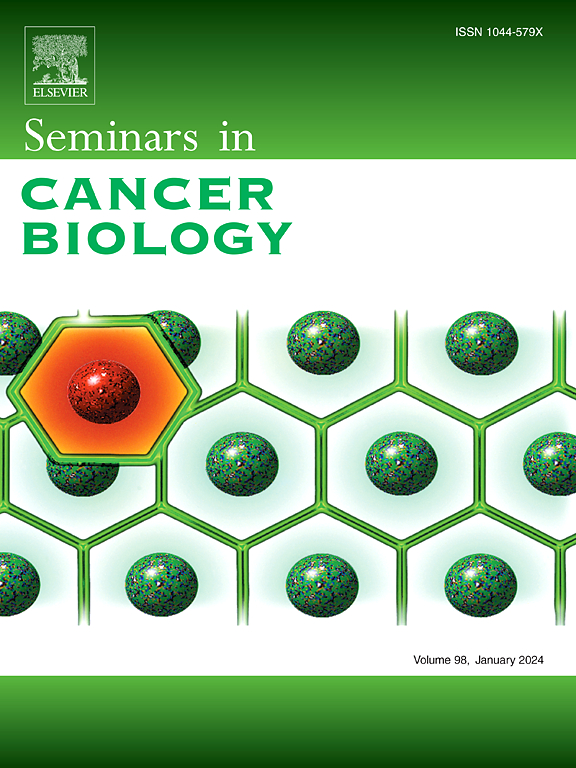Interplay of ferroptosis, cuproptosis, and PANoptosis in cancer treatment-induced cardiotoxicity: Mechanisms and therapeutic implications
IF 12.1
1区 医学
Q1 ONCOLOGY
引用次数: 0
Abstract
With the prolonged survival of individuals with cancer, the emergence of cardiovascular diseases (CVD) induced by cancer treatment has become a significant concern, ranking as the second leading cause of death among cancer survivors. This review explores three distinct types of programmed cell death (PCD): ferroptosis, cuproptosis, and PANoptosis, focusing on their roles in chemotherapy-induced cardiotoxicity. While ferroptosis and cuproptosis are triggered by excess iron and copper (Cu), PANoptosis is an inflammatory PCD with features of pyroptosis, apoptosis, and necroptosis. Recent studies reveal intricate connections among these PCD types, emphasizing the interplay between cuproptosis and ferroptosis. Notably, the role of intracellular Cu in promoting ferroptosis through GPX4 is highlighted. Additionally, ROS-induced PANoptosis is influenced by ferroptosis and cuproptosis, suggesting a complex interrelationship. This review provides insights into the molecular mechanisms of these PCD modalities and their distinct contributions to chemotherapy-induced cardiotoxicity. Furthermore, we discuss the potential application of cardioprotective drugs in managing these PCD types. This comprehensive analysis aims to advance the understanding, diagnosis, and therapeutic strategies for cardiotoxicity associated with cancer treatment.
铁凋亡、杯凋亡和泛凋亡在癌症治疗诱发的心脏毒性中的相互作用:机制和治疗意义。
随着癌症患者生存期的延长,癌症治疗诱发的心血管疾病(CVD)的出现已成为人们关注的焦点,并已成为癌症幸存者的第二大死因。本综述探讨了三种不同类型的程序性细胞死亡(PCD):铁凋亡、杯凋亡和泛凋亡,重点关注它们在化疗诱导的心脏毒性中的作用。铁细胞凋亡和铜细胞凋亡是由过量的铁和铜(Cu)引发的,而泛凋亡是一种炎症性 PCD,具有热凋亡、细胞凋亡和坏死的特征。最近的研究揭示了这些 PCD 类型之间错综复杂的联系,强调了铜凋亡和铁凋亡之间的相互作用。值得注意的是,研究强调了细胞内 Cu 通过 GPX4 促进铁蜕变的作用。此外,ROS 诱导的 PAN 细胞凋亡受到铁凋亡和铜凋亡的影响,这表明两者之间存在复杂的相互关系。本综述深入探讨了这些 PCD 模式的分子机制及其对化疗诱导的心脏毒性的不同贡献。此外,我们还讨论了心脏保护药物在控制这些 PCD 类型中的潜在应用。这一全面分析旨在促进对癌症治疗相关心脏毒性的理解、诊断和治疗策略。
本文章由计算机程序翻译,如有差异,请以英文原文为准。
求助全文
约1分钟内获得全文
求助全文
来源期刊

Seminars in cancer biology
医学-肿瘤学
CiteScore
26.80
自引率
4.10%
发文量
347
审稿时长
15.1 weeks
期刊介绍:
Seminars in Cancer Biology (YSCBI) is a specialized review journal that focuses on the field of molecular oncology. Its primary objective is to keep scientists up-to-date with the latest developments in this field.
The journal adopts a thematic approach, dedicating each issue to an important topic of interest to cancer biologists. These topics cover a range of research areas, including the underlying genetic and molecular causes of cellular transformation and cancer, as well as the molecular basis of potential therapies.
To ensure the highest quality and expertise, every issue is supervised by a guest editor or editors who are internationally recognized experts in the respective field. Each issue features approximately eight to twelve authoritative invited reviews that cover various aspects of the chosen subject area.
The ultimate goal of each issue of YSCBI is to offer a cohesive, easily comprehensible, and engaging overview of the selected topic. The journal strives to provide scientists with a coordinated and lively examination of the latest developments in the field of molecular oncology.
 求助内容:
求助内容: 应助结果提醒方式:
应助结果提醒方式:


